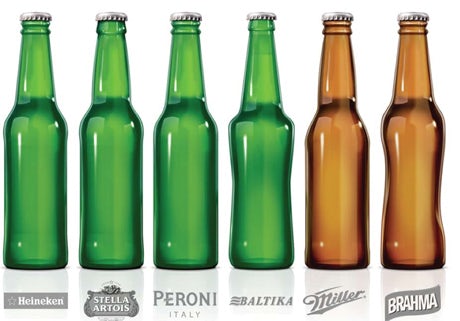Does your brand look good naked?
Stripping away the graphics, sometimes it’s hard to distinguish a brand from its competitors. That’s where structural packaging comes in, writes Heidi Maxwell, managing director of Touch Design.


To paraphrase the immortal words of TV presenter and fashion consultant Gok Wan: “Does your brand look good naked?” More importantly, is it differentiated? Is it ‘ownable’? Does it fit your brand proposition? Denuded of graphics and labelling, is it the physical embodiment of your brand? Does it function well and deliver a great consumer experience?
Your brand should still be your brand when you remove those beautiful graphics. A few years ago we did just that for a well-known global beer client and its competitors and were amazed at how similar the bottles of the different brands were. Even the beer aficionados among us struggled to tell the difference! Considering how sensorial the beer experience is, this wasn’t just a travesty of design, it completely missed the opportunity to engage consumers in a ritual and brand experience. I’m delighted to say the problem is now rectified with a more distinctive bottle shape, which will really be coming into its own with the growing challenge of global ‘dark markets’, where tightening regulations limit how alcohol brands can be marketed.
Today brand, graphics and structure are rightly recognised as the holy trinity of packaging design. Savvy marketers recognise that their product isn’t just the ‘thing’ or ‘stuff’ inside, but is a holistic, inseparable combination of product, branding, graphics and structural packaging. Packaging is an important part of the brand experience, an investment in the brand rather than a cost.
Structural packaging has the power to:
- Build ritual and emotional engagement.
- Turn commodities into premium brands.
- Create new usage occasions.
- Drive product category growth.
- Reduce unit costs (yes, really!).
- And ultimately drive sales.
When we searched for insights for Birds Eye on frozen peas, consumers told us that the packaging was “fine, thanks’’. Understandably, they just weren’t overtly interested. However, when we rummaged inside their freezers there were all kinds of imaginative coping mechanisms, confirming Henry Ford’s well-worn adage: “If I’d asked people what they wanted, they’d have said faster horses.”
Birds Eye used research to inspire rather than dictate design direction and the ziplock frozen pea bag was born. The packaging cost a little more to produce and meant an adaptation to the production line, but it has given consumers a reason to choose ‘brand’ over ‘commodity’. It’s still spontaneously cited by consumers as an example of where they are happy to pay a little more, because it solves a problem – a problem that they didn’t know they had!
So the key to creating a consumer’s perfect packaging lies in first understanding their needs and defining insights in a real-world context. Designing packs of Bisto gravy that met the rigours of a busy professional kitchen meant studying chefs’ habits in that environment in order to come up with a superior piece of multi-functional packaging that addressed their needs without adding on cost.
Development of a unique usage experience or ownable ritual is the holy grail for a structural packaging designer, and that stretches from exquisite designer fine fragrances to breakfast cereal. Care must be taken to understand and develop an enjoyable experience for the consumer.
In the case of Nespresso’s beautiful premium chocolates, which it sells online, even the delivery packaging was carefully considered. The outer casing must not only protect the chocolates through the post but also keep them within an optimal temperature range throughout transit for a period of up to 48 hours.

To ensure the chocolates reach the consumer in perfect condition, thermally insulated packaging was developed that not only kept the product cool, but did so in a way that wasn’t overtly obvious or detrimental to the premium consumer experience. In fact the pace and method of opening the box was actually developed to build the level of anticipation
of the product.
Designing globally, with a huge breadth of cultures and demographics, it is fascinating to see the subtle shifts in packaging formats and consumer desires across markets. A format considered the norm in Europe may be groundbreaking in Russia. What’s mainstream in the UK may be considered too premium
for some parts of America.
On top of this, we must overlay the challenge of the functional requirements of the packaging and the consumers that buy them.
For Unilever’s Robertsons herbs and spices brand in Africa, for example, the packaging must work in a tough, steamy kitchen environment for a dry product, and for a vast spectrum of consumers. These range from affluent top-tier consumers desiring optimal product and packaging performance (not to mention an enhanced creative cooking experience) down to the impoverished bottom-of-the-pyramid consumers whose need to fill hungry bellies with good, tasty food is a very down-to-earth experience. The solution, in fact, lay in two-tier ‘primary’ and ‘refill’ packaging.
The point is, what is a top priority for one consumer may be much lower down the list for another, and climate, environment, production capabilities and budget will all ultimately play a vital part in the brief. The key is to really understand the consumer: who uses the product, when and how. A two-litre bottle of milk must pour successfully and be manageable for hands aged from four to 84.
To give consumers a reason to buy your product ahead of the competition, you need a compelling concept built on a genuine insight, and that concept needs to be translated into the product packaging itself. So packaging design is not just about image, it’s about embracing behavioural, functional and action-oriented rituals to engage consumers emotionally. Sorry, Gok, I guess it’s just not enough to look good naked after all.
Heidi Maxwell
Managing director
Touch Design
New Lodge
Drift Road
Windsor
Berkshire SL4 4RR
T: 01344 894510
E: heidim@touchpackdesign.com
W: www.touchpackdesign.com







